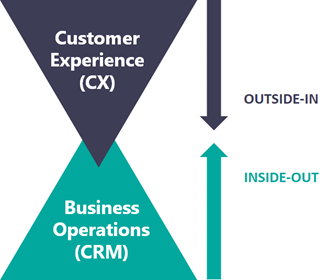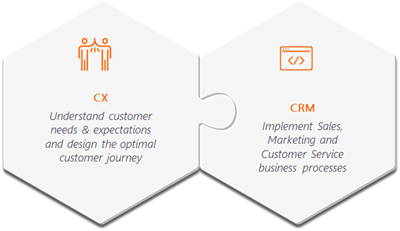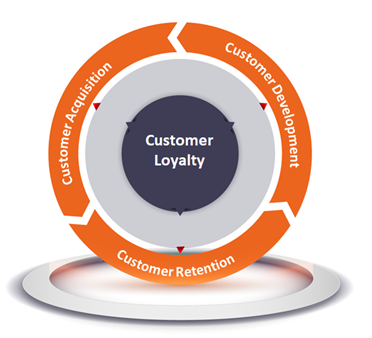How is Customer Experience management different to CRM?
Customer Relationship Management is a known practice that has been adopted by most organizations around the world to manage the sales, marketing and customer service processes.
If we focus on the CRM technology itself, while they have been widely used for many years, the reality is that CRM systems haven’t delivered the expected outcomes, both from an efficiency perspective as well as in relation to their impact on the end customers.
One of the key issues that is often overlooked, is the fact that CRM projects are too internally focused and handled as technology projects. The stakeholders that define the needs are the users of the system, which are not always aligned with the needs of customers – the primary stakeholders the system is eventually supposed to serve. It’s a customer relationship management system, isn’t it?
If we stick to this definition, then most naturally we should ask ourselves how customers would like their marketing, sales, customer service and field service experience to look like. Based on that, we can tailor the CRM processes to fit their needs and better reflect customer interactions, which will result in more satisfied customers and higher levels of loyalty.
Turning the way we approach the CRM implementations from the outside-in, assures that we are combining both the optimization of the internal relationship management processes, as well as considering the needs of customers throughout the deployment process, starting from setting the CRM strategy itself.

8 current challenges of CRM deployments

Trying to overcome CRM project implementation challenges has led organizations to focus on user adoption, working with agile methodologies and sticking to standard solutions to minimize specific customizations, which traditionally led to complexity and project over-runs.
However, while CRM is a mature practice, it still suffers from various challenges that make it a struggle to extract real value and support evolving business objectives. Here is a list of the main issues:
- Low CRM adoption: not all users are using the system and those that do use it are not using it frequently enough, a CRM system can be seen as additional software to use rather than part of daily work life, such as email or collaborative workspaces and chat
- Data quality: CRM systems heavily rely on accurate and up-to-date data. Maintaining data quality is time consuming, especially if there are inconsistencies in existing data sources or if data entry processes are not standardized
- Manual work: CRM systems are based on manual data entry by the user, they lack automation and their contribution to efficiency is limited
- Showing ROI: Quantifying the return on investment (ROI) of CRM implementations can be challenging, especially in seemingly intangible areas such as customer satisfaction and loyalty. Taking into consideration that the spending on CRM implementation and licensing is not minor, proving an investment payback is blurry at best
- Integration complexity: CRM systems are supposed to be the source for the customer 360 view, but the reality is that in most cases customer data is segregated in multiple systems making it hard to generate a comprehensive 360 view without investing in integrations that are costly and difficult to maintain over time
- Customization: Using the standard software versus tailoring it to fit the way the organization works is always a dilemma. If you do not customize you will need to change the ways of working and potentially the organizational structure and if you do customize you might be drifting away from best practices and adding an extra layer of maintenance. In either way it is hard to obtain an optimal result.
- Lack of executive support: Management buy-in is essential for securing resources, driving cultural change, and ensuring project success, but it is not always out there due to overload of priorities to manage or lack of understanding the value CRM could bring to the business
- A disjointed strategic approach: Connected to the above challenge, if a CRM system is operating in its own silo and just seen as a piece of technology, then it will always be outside of company strategy, processes and culture
How to improve CRM adoption with a CX approach
Improving CRM adoption with a Customer Experience (CX) approach involves integrating customer-centric principles into every phase of the CRM implementation process.
The combination of CX, providing an outside-in view of the customer journey, and CRM, providing an inside-out view of the way the relationship is managed from an internal perspective, are complementary approaches that bring a better result to the business because they are aligned both with customer needs and company strategy.

Let’s have a closer look at how the new proposed Customer Experience methodology combines the classic CRM implementation tasks with a CX flavor, bringing much more value and ROI.
The 6 phases of a CX-infused CRM project

- Initiation phase is focused on scoping the project and understanding customer needs and expectations. This is done through the execution of a customer journey mapping exercise that tells the storyline from a customer perspective, describing the way customers are experiencing the brand through the different communication channels (interactions).
The result: A list within an enriched project scope with defined boundaries and a desired outcome both from a business and a customer perspective. - Analysis phase is following the mapping of the journey and completing it by capturing customer needs using difference feedback collection methods, such as: data from VoC sources (Voice Of the Customer), surveys, focus groups, front-line employees, transactional data (Voice of the Business/Process) and more. The research data gathered is processed, analyzed and compiled into a list of opportunities to improve customer experience, which serves as the customer requirements in addition to the user requirements.
The result: The lists are combined and prioritized to decide which actions will be delivered in which version of the deployment in your CRM roadmap. - Design phase is focused on mapping the service blueprints, which looks at optimizing the operating model that drives the backstage processes supporting the customer journey. These will identify changes that are necessary internally in information systems, departments and business processes to comply with customer expectations.
The result: A list of process flows for implementation (desired future state) with a gap analysis versus the current state. - Implementation phase is executing the new process flows customizing the CRM system to fit the requirements of the users and the customers as defined in the scope of the version. The customizations and the testing are conducted in several CRP (Conference Room Pilot) cycles running through test scenarios that are executed on one side by the key users performing acceptance tests and on the other side by a selected group of customers (customer forum) testing and providing feedback on the newly designed processes. When the result is satisfying and signed-off by the users (after taking into account the customer feedback) the project is ready to move to the deployment phase.
- Deployment phase is informing customers of the customer-facing actions that have been taken in the communication channels as part of the version release in Production, looking to capture feedback and fine-tune. Users are trained in the new ways of working and monitoring dashboards are activated to track the business performance, adherence to expected usage by role and process which follow the defined customer experience metrics.
- Adoption phase is a continuous improvement cycle of collecting customer feedback, analyzing it and acting upon it as part of the scheduled evolutions within the change management track. The pool of evolutions is filled from both user requirements and customer needs, this consolidated list is prioritized and the flow of selected features is transferred to execution batches.
The effort of adopting the proposed approach is not that significant, most of the data is already available in the organization in various information systems and just needs to be streamed and centralized through a customer journey map.
By gathering customer requirements, we are injecting into the implementation process a better understating of the way internal processes should flow to satisfy customer needs and expectations. This technique will not only benefit the CRM implementation, it could also feed other initiatives in the organization that require customer feedback to give better results.
Measuring ROI on CRM and Customer Experience (CX)
When discussing ROI models for CRM systems we naturally look for sales performance indicators, employee productivity, marketing automation or customer service satisfaction metrics. I believe that the true ROI measurement is the impact the CRM system will have on customer experience. The value of having a better experience is fulfilling the exact purpose for which the CRM system was implemented in the first place -> to foster loyalty.
So how is the best CRM ROI model combining the two approaches together?
In fact, the performance indicators are the same, they are just completed with experience metrics to track the progress of both in parallel. The improvement of customer experience results in a direct impact on sales, marketing and customer service performance. This will be expressed in better customer service, more efficient sales processes, a larger pipeline, decreased churn rate, better data-driven decisions, improved collaboration and communication both internally and with customers, etc.

The traditional ROI formula for CRM systems looks at the advantages to the business following the implementation of the CRM system minus the investments implementing it:
CRM ROI = (Gain from Investment into CRM – Cost of investment) ÷ Cost of Investment
The updated model, taking into consideration customer experience, is now integrating the benefits related to the customer (Gains).
The new formula will look like this:
CRM & CX ROI = (Gain to the customer and the business from investment into CRM – Cost of investment) ÷ Cost of Investment.
This updated formula better reflects the return on investment, because increased loyalty does generate revenue back to the company that can be measured through referrals, churn rate, renewals, cross/up-sell opportunities, etc.
Examples of specific metrics to measure are provided in the following table to select from based on your industry and those metrics your organization can measure.
In front of every business metric, “experience metrics” need to be aligned so the impact of customer experience improvement on the business outcomes can be measured.
| Examples of Business Metrics | Examples of Experience Metrics |
|---|---|
| Sales Pipeline | Customer Lifetime Value |
| Leads Generation | Referrals |
| Conversion Rate | Customer Satisfaction |
| Number of cases | NPS |
| SLA | Customer Effort |
| Revenue from new deals | Brand reputation |
| Revenue from renewals | Churn Rate |
Make a better connection between CRM, employee and customer
Did you ever ask yourself the question why you implemented a CRM system? Is it because it’s a trend to have one? Maybe you wanted to improve sales efficiency or the quality of customer service?

Either way the probable expectation, derived simply from the name of this technology, is that you wanted to improve the relationship with your customers, gain more business value from attracting new customers, retain the existing install-base and develop cross-sell/up-sell opportunities.
While the objective is clear, the road to get there hasn’t been proven to satisfy the purpose, which is why I’m proposing a new point of view, to provide users with an intuitive system and customers with a better experience.
Focusing only on user requirements, or being seduced by technological features, hasn’t provided a good enough result, even if all needs are satisfied and the system is tailored to the specific requirements of the user, there will always be the risk of having a gap versus what customers are expecting to experience at the marketing, sales and service stages.
Overlooking the way customers are experiencing the CRM processes is like trying to walk with only one shoe on, now it’s time to put the other shoe and walk the right way.






